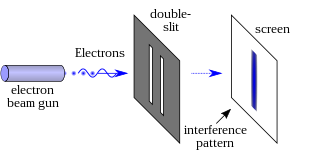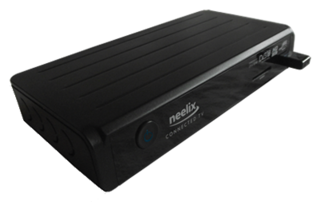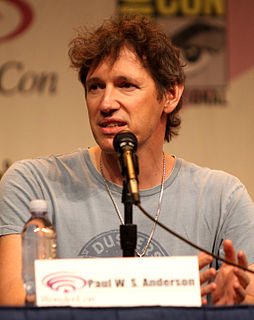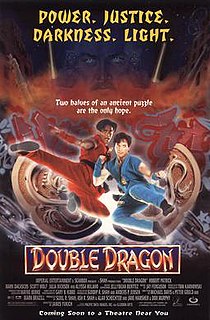
Blackjack is a casino banking game. The most widely played casino banking game in the world, it uses decks of 52 cards and descends from a global family of casino banking games known as Twenty-One. This family of card games also includes the British game of Pontoon and the European game, Vingt-et-Un. Blackjack players do not compete against each other. The game is a comparing card game where each player competes against the dealer.

In modern physics, the double-slit experiment is a demonstration that light and matter can display characteristics of both classically defined waves and particles; moreover, it displays the fundamentally probabilistic nature of quantum mechanical phenomena. This type of experiment was first performed, using light, by Thomas Young in 1801, as a demonstration of the wave behavior of light. At that time it was thought that light consisted of either waves or particles. With the beginning of modern physics, about a hundred years later, it was realized that light could in fact show behavior characteristic of both waves and particles. In 1927, Davisson and Germer demonstrated that electrons show the same behavior, which was later extended to atoms and molecules. Thomas Young's experiment with light was part of classical physics long before the development of quantum mechanics and the concept of wave–particle duality. He believed it demonstrated that the wave theory of light was correct, and his experiment is sometimes referred to as Young's experiment or Young's slits.

A set-top box (STB), also colloquially known as a cable box and historically television decoder, is an information appliance device that generally contains a TV-tuner input and displays output to a television set and an external source of signal, turning the source signal into content in a form that can then be displayed on the television screen or other display device. They are used in cable television, satellite television, and over-the-air television systems as well as other uses.

Video is an electronic medium for the recording, copying, playback, broadcasting, and display of moving visual media. Video was first developed for mechanical television systems, which were quickly replaced by cathode-ray tube (CRT) systems which were later replaced by flat panel displays of several types.

SCART is a French-originated standard and associated 21-pin connector for connecting audio-visual (AV) equipment. The name SCART comes from Syndicat des Constructeurs d'Appareils Radiorécepteurs et Téléviseurs, "Radio and Television Receiver Manufacturers' Association", the French organisation that created the connector in the mid-1970s. The related European standard EN 50049 has then been refined and published in 1978 by CENELEC, calling it péritelevision, but it is commonly called by the abbreviation péritel in French.

Sloan is a Canadian rock band based in Toronto and originally from Halifax, Nova Scotia. Sloan have released twelve full-length albums and have received nine Juno Award nominations, winning one. Between 1996 and 2016, Sloan was among the top 75 best-selling Canadian artists in Canada and among the top 25 best-selling Canadian bands in Canada. The band is known for their sharing of songwriting and lead vocals from each member of the group and their unaltered line-up throughout their career.
Collision detection is the computational problem of detecting the intersection of two or more objects. Collision detection is a classic issue of computational geometry and has applications in various computing fields, primarily in computer graphics, computer games, computer simulations, robotics and computational physics. Collision detection algorithms can be divided into operating on 2D and 3D objects.

Pokémon Ruby Version and Pokémon Sapphire Version are 2002 role-playing video games developed by Game Freak, published by The Pokémon Company and Nintendo for the Game Boy Advance. They are the first installments in the third generation of the Pokémon video game series, also known as the "advanced generation". After years of Nintendo being the sole publisher of the franchise in all regions, The Pokémon Company co-published the games for the first time since the establishment of the joint-owned company in 1998. They were first released in Japan in late 2002, and internationally in 2003. Pokémon Emerald, an enhanced version, was released two years later in each region. Remakes of the two games, titled Pokémon Omega Ruby and Alpha Sapphire, were released for the Nintendo 3DS worldwide in November 2014, exactly twelve years to the date of the original Ruby and Sapphire release date, with the exception of Europe, where it released a week later.

Monaural or monophonic sound reproduction is sound intended to be heard as if it were emanating from one position. This contrasts with stereophonic sound or stereo, which uses two separate audio channels to reproduce sound from two microphones on the right and left side, which is reproduced with two separate loudspeakers to give a sense of the direction of sound sources. In mono, only one loudspeaker is necessary, but, when played through multiple loudspeakers or headphones, identical signals are fed to each speaker, resulting in the perception of one-channel sound "imaging" in one sonic space between the speakers. Monaural recordings, like stereo ones, typically use multiple microphones fed into multiple channels on a recording console, but each channel is "panned" to the center. In the final stage, the various center-panned signal paths are usually mixed down to two identical tracks, which, because they are identical, are perceived upon playback as representing a single unified signal at a single place in the soundstage. In some cases, multitrack sources are mixed to a one-track tape, thus becoming one signal. In the mastering stage, particularly in the days of mono records, the one- or two-track mono master tape was then transferred to a one-track lathe used to produce a master disc intended to be used in the pressing of a monophonic record. Today, however, monaural recordings are usually mastered to be played on stereo and multi-track formats, yet retain their center-panned mono soundstage characteristics.
Deinterlacing is the process of converting interlaced video into a non-interlaced or progressive form. Interlaced video signals are commonly found in analog television, digital television (HDTV) when in the 1080i format, some DVD titles, and a smaller number of Blu-ray discs.
Source is a 3D game engine developed by Valve. It debuted as the successor to GoldSrc with Half-Life: Source in June 2004, followed by Counter-Strike: Source and Half-Life 2 later that year. Source does not have a concise version numbering scheme; instead, it is designed in constant incremental updates. The engine was succeeded by Source 2.

Paul William Scott Anderson is an English film director, producer, and screenwriter who regularly works in science fiction films and video game adaptations.

The double feature was a motion picture industry phenomenon in which theatres would exhibit two films for the price of one, supplanting an earlier format in which one feature film and various short subject reels would be shown.

Double Dragon is a 1994 American martial arts film based on the video game series of the same name and directed by James Yukich. It stars Mark Dacascos and Scott Wolf as brothers Jimmy and Billy Lee, along with Alyssa Milano as Marian Delario and Robert Patrick as antagonist Koga Shuko. The film takes place in an earthquake-crippled Los Angeles in 2007; the city is styled as a mix between a post-apocalyptic and 80s/90s punk environment. It failed both critically and financially, receiving generally negative reviews, with praise for its special effects and action sequences, but criticism for its writing and performances.

Oracle VM VirtualBox is a type-2 hypervisor for x86 virtualization developed by Oracle Corporation.
Television standards conversion is the process of changing a television transmission or recording from one television system to another. The most common is from NTSC to PAL or the other way around. This is done so television programs in one nation may be viewed in a nation with a different standard. The video is fed through a video standards converter, which makes a copy in a different video system.
High-definition television describes a television system providing a substantially higher image resolution than the previous generation of technologies. The term has been used since 1936, in more recent times it refers to the generation following standard-definition television (SDTV), often abbreviated to HDTV or HD-TV. It is the current de facto standard video format used in most broadcasts: terrestrial broadcast television, cable television, satellite television and Blu-ray Discs.

Access All Areas: A Rock & Roll Odyssey is a documentary following rock band Bon Jovi on their successful New Jersey Syndicate Tour between 1988 and 1990. It contains live, backstage, and candid footage of the band, soundtracked with their music. The film was initially released on VHS in 1990 and on DVD in 2014 as part of the New Jersey: Super Deluxe Edition, along with New Jersey: The Videos.
Analog passthrough is a feature found on some digital-to-analog television converter boxes. Boxes without analog passthrough only allow digital TV to be viewed on older, analog-only TVs. Those with analog passthrough allow both digital and analog television to be viewed on older TVs.
Facepunch Studios Ltd is a British video game developer and publisher headquartered in Walsall, England, founded in June 2004 and incorporated on 17 March 2009 by Garry Newman. The company is most known for its sandbox video game Garry's Mod and survival game Rust. Facepunch are currently developing a successor to Garry's Mod titled s&box.












